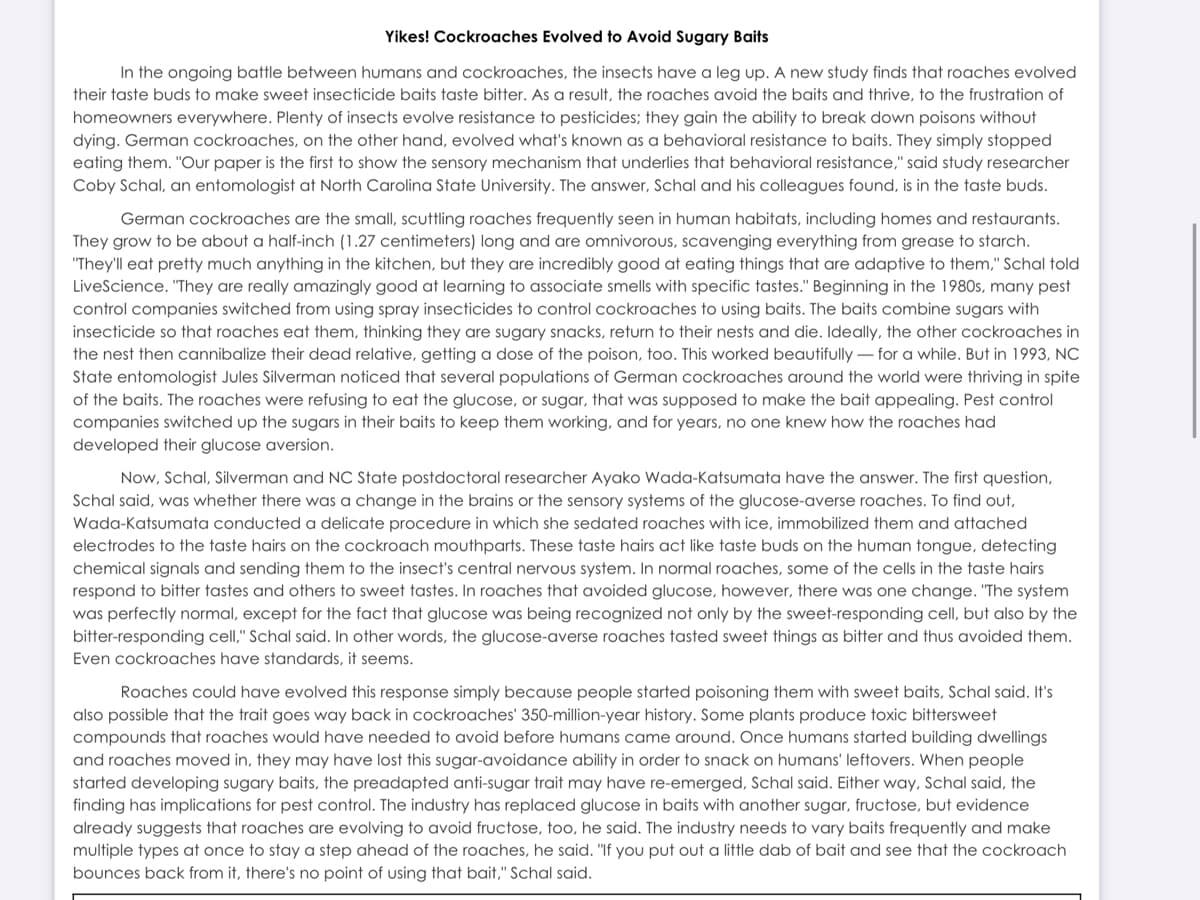Biology: The Unity and Diversity of Life (MindTap Course List)
14th Edition
ISBN:9781305073951
Author:Cecie Starr, Ralph Taggart, Christine Evers, Lisa Starr
Publisher:Cecie Starr, Ralph Taggart, Christine Evers, Lisa Starr
Chapter33: Sensory Perception
Section: Chapter Questions
Problem 1CT: Like other nocturnal carnivores, the ferret shown in FIGURE 33.13 has light-reflecting material in...
Related questions
Question
Using DIRECT evidence from the text, provide a biological explanation for why pest companies should limit the production of sugary baits in order to control cockroaches.
USE THE TERMS: behavioral resistance, glucose, taste buds
THIS IS NOT ESSAY OR WRITING HELP!!

Transcribed Image Text:Yikes! Cockroaches Evolved to Avoid Sugary Baits
In the ongoing battle between humans and cockroaches, the insects have a leg up. A new study finds that roaches evolved
their taste buds to make sweet insecticide baits taste bitter. As a result, the roaches avoid the baits and thrive, to the frustration of
homeowners everywhere. Plenty of insects evolve resistance to pesticides; they gain the ability to break down poisons without
dying. German cockroaches, on the other hand, evolved what's known as a behavioral resistance to baits. They simply stopped
eating them. "Our paper is the first to show the sensory mechanism that underlies that behavioral resistance," said study researcher
Coby Schal, an entomologist at North Carolina State University. The answer, Schal and his colleagues found, is in the taste buds.
German cockroaches are the small, scuttling roaches frequently seen in human habitats, including homes and restaurants.
They grow to be about a half-inch (1.27 centimeters) long and are omnivorous, scavenging everything from grease to starch.
"They'll eat pretty much anything in the kitchen, but they are incredibly good at eating things that are adaptive to them," Schal told
LiveScience. "They are really amazingly good at learning to associate smells with specific tastes." Beginning in the 1980s, many pest
control companies switched from using spray insecticides to control cockroaches to using baits. The baits combine sugars with
insecticide so that roaches eat them, thinking they are sugary snacks, return to their nests and die. Ideally, the other cockroaches in
the nest then cannibalize their dead relative, getting a dose of the poison, too. This worked beautifully – for a while. But in 1993, NC
State entomologist Jules Silverman noticed that several populations of German cockroaches around the world were thriving in spite
of the baits. The roaches were refusing to eat the glucose, or sugar, that was supposed to make the bait appealing. Pest control
companies switched up the sugars in their baits to keep them working, and for years, no one knew how the roaches had
developed their glucose aversion.
Now, Schal, Silverman and NC State postdoctoral researcher Ayako Wada-Katsumata have the answer. The first question,
Schal said, was whether there was a change in the brains or the sensory systems of the glucose-averse roaches. To find out,
Wada-Katsumata conducted a delicate procedure in which she sedated roaches with ice, immobilized them and attached
electrodes to the taste hairs on the cockroach mouthparts. These taste hairs act like taste buds on the human tongue, detecting
chemical signals and sending them to the insect's central nervous system. In normal roaches, some of the cells in the taste hairs
respond to bitter tastes and others to sweet tastes. In roaches that avoided glucose, however, there was one change. "The system
was perfectly normal, except for the fact that glucose was being recognized not only by the sweet-responding cell, but also by the
bitter-responding cell," Schal said. In other words, the glucose-averse roaches tasted sweet things as bitter and thus avoided them.
Even cockroaches have standards, it seems.
Roaches could have evolved this response simply because people started poisoning them with sweet baits, Schal said. It's
also possible that the trait goes way back in cockroaches' 350-million-year history. Some plants produce toxic bittersweet
compounds that roaches would have needed to avoid before humans came around. Once humans started building dwellings
and roaches moved in, they may have lost this sugar-avoidance ability in order to snack on humans' leftovers. When people
started developing sugary baits, the preadapted anti-sugar trait may have re-emerged, Schal said. Either way, Schal said, the
finding has implications for pest control. The industry has replaced glucose in baits with another sugar, fructose, but evidence
already suggests that roaches are evolving to avoid fructose, too, he said. The industry needs to vary baits frequently and make
multiple types at once to stay a step ahead of the roaches, he said. "If you put out a little dab of bait and see that the cockroach
bounces back from it, there's no point of using that bait," Schal said.
Expert Solution
This question has been solved!
Explore an expertly crafted, step-by-step solution for a thorough understanding of key concepts.
This is a popular solution!
Trending now
This is a popular solution!
Step by step
Solved in 2 steps

Knowledge Booster
Learn more about
Need a deep-dive on the concept behind this application? Look no further. Learn more about this topic, biology and related others by exploring similar questions and additional content below.Recommended textbooks for you

Biology: The Unity and Diversity of Life (MindTap…
Biology
ISBN:
9781305073951
Author:
Cecie Starr, Ralph Taggart, Christine Evers, Lisa Starr
Publisher:
Cengage Learning

Biology: The Unity and Diversity of Life (MindTap…
Biology
ISBN:
9781337408332
Author:
Cecie Starr, Ralph Taggart, Christine Evers, Lisa Starr
Publisher:
Cengage Learning

Biology (MindTap Course List)
Biology
ISBN:
9781337392938
Author:
Eldra Solomon, Charles Martin, Diana W. Martin, Linda R. Berg
Publisher:
Cengage Learning

Biology: The Unity and Diversity of Life (MindTap…
Biology
ISBN:
9781305073951
Author:
Cecie Starr, Ralph Taggart, Christine Evers, Lisa Starr
Publisher:
Cengage Learning

Biology: The Unity and Diversity of Life (MindTap…
Biology
ISBN:
9781337408332
Author:
Cecie Starr, Ralph Taggart, Christine Evers, Lisa Starr
Publisher:
Cengage Learning

Biology (MindTap Course List)
Biology
ISBN:
9781337392938
Author:
Eldra Solomon, Charles Martin, Diana W. Martin, Linda R. Berg
Publisher:
Cengage Learning